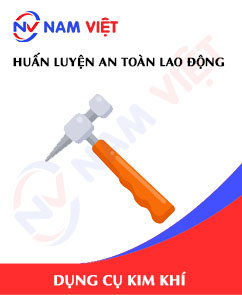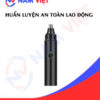Occupational Safety Training in Handheld Metalworking Tools Manufacturing
99,000 ₫
Note: The above price is calculated for one person, the price may fluctuate depending on the number of trainees participating in the course and depending on market movements. For more accurate pricing support, please refer to the quotation table or contact our consulting staff directly.
Occupational safety is an important issue in handheld metalworking tools manufacturing factories and needs to be addressed promptly to ensure the health and safety of workers, and to enhance the reputation of businesses. The Occupational safety training course is one of the effective solutions to raise awareness about accident prevention for workers participating in handheld metalworking tools manufacturing.
Table of Contents
Toggle1. Overview of Handheld Metalworking Tools
a. What are handheld metalworking tools?
Handheld metalworking tools are instruments used to cut, plane, grind, drill, press, bend, and shape metal materials during the production process. They include tools such as cutting knives, saws, screwdrivers, pliers, wrenches, hammers, grinders, and hand drills.
These tools are commonly used in metal manufacturing industries such as mechanical engineering, automotive production, and electronics. However, their use can pose hazards to users, such as injuries, workplace accidents, and musculoskeletal disorders if safety procedures are not properly followed.

b. Machinery for manufacturing handheld metalworking tools
The production of handheld metalworking tools generally includes cutting, processing, grinding, plating, coloring, polishing, assembly, and packaging. Machines used in this process include:
- Metal cutting machines: used to cut metal sheets into molds or shapes required for the products.
- Metal lathes: used to process metal components with high precision.
- Metal grinders: used for polishing, grinding, or repairing metal components.
- Sandblasting machines: used to create finished surfaces, matte effects, or increase coating adhesion.
- Metal plating machines: used to coat metals to prevent corrosion or create special color effects.
- Packaging machines: used to pack products before delivery to customers.
Additionally, workers often use handheld tools such as knives, scissors, wrenches, and polishing brushes for manual tasks during production.

c. Handheld metalworking tool manufacturers in Vietnam
There are many well-known brands of handheld metalworking tools in the market, including:
- Stanley: a renowned American brand with over 170 years of experience producing high-quality metalworking tools.
- DeWalt: a famous American brand producing specialized metalworking tools for construction and repair.
- Bosch: a well-known German brand offering high-quality products in industrial and commercial sectors.
- Makita: a Japanese brand famous for power tools and handheld metalworking tools.
- Metabo: a German brand with over 90 years of experience producing high-quality handheld metalworking tools.
- Hilti: a brand from Liechtenstein producing specialized tools for the construction industry, including handheld metalworking tools.
- TTI: a multinational corporation headquartered in Hong Kong owning several well-known handheld tool brands such as Milwaukee, Ryobi, and AEG.
- Black+Decker: an American brand specializing in power tools and handheld metalworking tools for home and industrial use.
d. Specific roles in handheld metalworking tool factories
Group 1
- Chief Executive Officer, Deputy CEO, and department heads in handheld metalworking tool factories.
Group 2
- Safety officers: manage workplace safety, design safety procedures, supervise, and ensure employees comply with safe working processes.
Group 3
- Material procurement: The materials department is responsible for purchasing raw materials such as steel, aluminum, copper, stainless steel, and other materials for producing handheld metalworking tools.
- Cutting, bending, and processing: After receiving materials, workers cut, bend, plane, and process them to shape the components of handheld metalworking tools.
- Welding and assembling parts: Processed components are welded or assembled to form complete tools.
- Polishing and finishing: Tools are polished and finished after welding or assembly to ensure quality and durability.
- Quality inspection: Tools are checked for quality before being released to the market to ensure they meet safety and quality standards.
- Packing and shipping: Finally, tools are packaged and shipped to retailers or direct customers.
Group 4
- Office work, service, sales, and marketing.
- Production management, quality management, human resource management, materials management, financial and accounting management.
- Product design: Mechanical engineers design handheld metalworking tools based on customer and market needs.

e. Common handheld metalworking tools
There are many common handheld metalworking tools. Some examples include:
- Cutting pliers: used to cut wires, cables, steel wires, plastic pipes, etc.
- Wrenches: used to tighten or loosen nuts and bolts.
- Adjustable wrenches: used to grip, clamp, or bend small metal parts, cut cable strands, etc.
- Pipe wrenches: used to open small nuts, tighten and assemble small components.
- Metal cutting knives: used to cut metal materials such as steel, iron, copper, aluminum, etc.
- Crimping pliers: used to crimp network cable ends, electrical connectors, etc.
- Rivets: used to fasten nails into materials such as wood or walls.
- Screwdrivers: used to open nuts, bolts, and valves.
- Grinders: used to grind metal materials such as cutting knives, saw blades, etc.
- Drills: used to make holes in metal materials.
2. Overview of occupational safety training for handheld metalworking tool production
This article focuses on Group 3, because Group 3 is directly involved in the production process and is exposed to the highest occupational safety risks. Learn more about other groups here.
a. What is Group 3 occupational safety training?
- Group 3 occupational safety training consists of sessions that equip workers with knowledge and awareness on preventing workplace accidents.
- The training course helps workers identify and avoid hazards, reducing the risks of workplace accidents during work.
REGISTER FOR OCCUPATIONAL SAFETY TRAINING SERVICE
b. Training duration
Initial safety training
- Total training time is at least 24 hours, including assessment time.
- 8 hours of theoretical study on the system of policies and laws on occupational safety and hygiene.
- 8 hours of theoretical study on basic knowledge of occupational safety and hygiene.
- 4 hours of theoretical study on specialized training content.
- 2 hours of practical study on specialized training content.
- 2 hours of final theoretical assessment at the end of the course.
The safety training center will divide the time into multiple sessions depending on the workers’ schedule. Typically, there are 6 training sessions over 3 days, provided the production company can arrange continuous study time.
Periodic safety training
- Before the occupational safety card expires, workers wishing to renew it must undergo periodic occupational safety training, with periodic training duration at least 50% of the initial safety training duration.
Explanation: Total periodic safety training time is at least 12 hours, including assessment time. After completing the periodic training and passing the assessment, the worker will be reissued or have their occupational safety card renewed.
c. Training content
| No. | TRAINING CONTENT | TRAINING TIME (HOURS) | |||
| Total | Including | ||||
| Theory | Practice | Assessment | |||
| I | System of policies and laws on occupational safety and hygiene | 8 | 8 | 0 | 0 |
| 1 | Overview of the system of legal documents on occupational safety and hygiene. | 6 | 6 | ||
| 2 | Standards and technical regulations on occupational safety and hygiene. | 1 | 1 | ||
| 3 | Specific regulations from state management agencies on occupational safety and hygiene when constructing, expanding, or renovating facilities for production, usage, storage, and inspection of machinery, equipment, materials, and substances with strict safety requirements. | 1 | 1 | ||
| II | Basic knowledge of occupational safety and hygiene | 8 | 8 | 0 | 0 |
| 1 | Basic knowledge of hazardous and harmful factors in the workplace. | 4 | 4 | ||
| 2 | Methods to improve working conditions. | 1 | 1 | ||
| 3 | Safety culture in production and business. | 1 | 1 | ||
| 4 | Rights and obligations of employers and employees; policies on occupational safety and hygiene for employees; roles and duties of safety network personnel. | 1 | 1 | ||
| 5 | Safety and hygiene regulations, signs, safety instructions, use of safety equipment and personal protective equipment; first aid skills for workplace accidents and occupational disease prevention. | 1 | 1 | ||
| III | Specialized training content | 6 | 4 | 2 | 0 |
| Comprehensive knowledge of machinery, equipment, and substances generating hazardous factors; risk analysis, evaluation, management of occupational safety and hygiene, and safe working procedures with machinery, equipment, and substances with strict safety requirements. | 6 | 4 | 2 | ||
| IV | Final assessment of occupational safety training | 2 | 2 | 0 | 0 |
| Total | 24 | 22 | 2 | ||
See more training content of all 6 groups
d. Occupational safety card
After completing the occupational safety training and passing the assessment, workers will be issued an occupational safety card (commonly called a Group 3 occupational safety certificate).
The Group 3 safety card clearly shows the worker’s name, date of birth, job, and specific working environment. It also includes training duration, red stamp, and signature confirming course completion.
According to Clause 2 of Article 24 of Decree 44/2016/ND-CP, there are two cases:
- If the employer and the employee have a labor contract, the employer must sign, stamp, and validate the safety card for Group 3 trainees after they complete the training provided by an occupational safety training unit and pass the assessment.
- If the worker is freelance or temporary and does not have a labor contract, the training unit must sign, stamp, and validate the safety card for the worker after they complete the occupational safety training and pass the assessment.

3. Identifying Hazards Affecting Workers in Handheld Metalworking Tools Manufacturing
Some hazards that may affect workers when producing handheld metalworking tools include:
- Hazard from sharp edges: The cutting edges of handheld metalworking tools, such as knives, scissors, and saws, can cause injuries or trauma to workers if not used properly or stored safely.
- Electrical hazards: If electrical equipment in the factory is not regularly maintained, properly insulated, or waterproofed, it can pose a risk of electric shock to workers during production.
- Spark hazards: Using handheld metalworking tools may sometimes generate sparks, posing a danger to workers in environments containing flammable or explosive materials.
- Metal dust hazards: During metal processing, fine metal dust can be generated, which may harm workers’ health if inhaled.
- Noise hazards: Machines used in handheld metalworking tool production generate high noise levels, which can damage workers’ hearing if not properly controlled or protected with ear protection equipment.
- Toxic gas hazards: Solvents and chemicals used during handheld metalworking tool production may be harmful to workers’ health if not handled correctly or adequately protected.
4. Common Occupational Accidents in Handheld Metalworking Tools Manufacturing
Some common occupational accidents in handheld metalworking tool production include:
- Cuts and punctures: Sharp tools such as scissors, knives, punches, screwdrivers, and wrenches can cause cuts or puncture wounds on workers’ skin if protective equipment is not worn.
- Slips and falls: Working in industrial environments with scattered tools, slippery floors, stairs, or compressed air pipes can lead to slip and fall accidents.
- Collisions: Improperly stored or transported handheld metalworking tools may collide with each other, causing risks such as breakage, damage, punctures, cracks, or fractures.
- Poisoning: Chemicals used for cleaning, lubricating, painting, or coating handheld metalworking tools may produce toxic fumes that can affect workers’ health if protective equipment is not used.
- Vibration injuries: Using handheld metalworking tools may generate vibrations, causing fatigue and injuries to workers’ muscles, joints, and bones.

5. Safety Measures in Handheld Metalworking Tool Manufacturing
Safety measures in handheld metalworking tool production include:
- Occupational Safety Training: Workers should be trained on work procedures, production processes, tool and equipment usage, safety measures, and accident prevention.
- Use of protective equipment: Workers should be provided with protective gear such as safety goggles, masks, gloves, waterproof jackets, and anti-slip shoes to minimize risk of injury.
- Proper use of tools: Workers must use tools and equipment correctly, following production rules and regulations to reduce accident risks.
- Equipment maintenance: Production equipment should be regularly inspected and maintained to ensure safe and effective operation.
- Hygiene and environmental safety: Factories should implement environmental hygiene measures, control pollution, and ensure safety for workers and surrounding communities.
- Monitoring and raising safety awareness: Workers should be periodically monitored for compliance with safety procedures. Companies should hold meetings and workshops to enhance safety awareness and implement optimal solutions for production safety.
- Regular workplace environmental monitoring to collect and analyze harmful factors affecting workers, allowing adjustments to reduce risks and prevent occupational diseases.
6. Benefits of Occupational Safety Training in Handheld Metalworking Tools Manufacturing
An Toan Nam Viet provides businesses with the following benefits after completing occupational safety training courses in compliance with Decree 44/2016/ND – CP regarding occupational safety and hygiene:
- Workers can identify potential accident hazards and implement preventive measures to avoid accidents.
- Businesses can establish risk prevention measures in production, operation, and maintenance processes.
- Reduction of costs associated with workplace safety risks.
- Continuous production without interruptions, increasing labor productivity and product quality.
- Compliance with labor safety laws, avoiding legal risks.
- Enhancing professionalism and company reputation, thereby strengthening brand value.
Nam Viet’s training courses are designed to help individuals prevent external risks, avoiding injuries or even fatalities.
REGISTER FOR OCCUPATIONAL SAFETY TRAINING SERVICE
7. Customer Feedback After Completing Handheld Metalworking Tool Occupational Safety Training
An Toan Nam Viet has many years of experience accompanying businesses across Vietnam, especially in southern provinces. This responsibility is extremely valuable to Nam Viet, which is why our occupational safety training is increasingly professional. Our growth is driven by both positive feedback and constructive suggestions from our business partners. Below are some testimonials from clients we have served:
Hoa Dat Construction and Trading Joint Stock Company
“Nam Viet’s service greatly helped us simplify occupational safety procedures and complete safety documentation for work processes. The advisory team responded promptly to our questions. Five stars for Nam Viet!”
See more customer interviews after using the service of An Toan Nam Viet
8. Occupational Safety Training Capacity of An Toan Nam Viet
An Toan Nam Viet is a reputable and high-quality occupational safety training center in Vietnam. Our training sessions are conducted continuously at production workshops, factories, or construction sites across the country (all 63 provinces of Vietnam).
REGISTER FOR OCCUPATIONAL SAFETY TRAINING SERVICE
Occupational Safety Training License
- An Toan Nam Viet has been inspected and certified by the Department of Occupational Safety under the Ministry of Labor, Invalids, and Social Affairs and granted a certificate of eligibility to operate occupational safety and hygiene training. This further strengthens our operational capacity in occupational safety training.

Training Materials and Lectures
- Before being included in occupational safety training courses, training materials are reviewed and verified to ensure accuracy of knowledge and effective application.
- Our instructors’ teaching methods are standardized according to An Toan Nam Viet’s guidelines, based on research and experience in occupational safety and hygiene training, designed to maximize knowledge retention for trainees.
Facilities
- Controlling classroom factors affecting the training process increases teaching efficiency and learners’ knowledge retention.
- Our training facilities provide spacious classrooms meeting standards for area, lighting, and training equipment, etc.
9. Nationwide Reputable Occupational Safety Training Center
At An Toan Nam Viet, we prioritize professional dedication in occupational safety training. For us, imparting knowledge to help workers protect themselves ensures they are safe while earning a living, contributing to nation-building.
To ensure effective training, we meticulously prepare every detail, from teaching tools and equipment to manuals, documents, audio, and lighting.
Our occupational safety instructors are experts with many years of field experience, including research on hazard identification across various industries and prevention methods.
Lessons are based on practical experience and delivered vividly for easy understanding. These factors help workers learn comfortably and absorb knowledge effectively, while always aligning with Decree 44/2016/ND-CP.
As a result, workers learn multiple hazard prevention measures and self-protection methods, applying them appropriately in real work situations.
Our training center proudly provides professional, reputable occupational safety training with the following advantages:
- Competitive training fees while ensuring high-quality instruction.
- Flexible training schedules adapted to company production.
- Quick certification procedures compliant with legal regulations.
- Experienced instructors with many years in the profession.
- Classrooms controlled for optimal learning conditions to improve teaching efficiency and knowledge absorption.
- Lessons are tailored to occupational safety in enterprises.
- An Toan Nam Viet works dedicatedly and professionally to provide accurate and prompt customer support.

10. Additional References for Occupational Safety Training in Handheld Metalworking Tools Manufacturing
- Occupational Safety Materials for Handheld Metalworking Tools Manufacturing
- Occupational Safety Training Materials Set
- Occupational Safety Training Test Set
- Occupational Safety Training Curriculum for Handheld Metalworking Tools Manufacturing
- Occupational Safety Quiz for Handheld Metalworking Tools Manufacturing
1 review for Occupational Safety Training in Handheld Metalworking Tools Manufacturing
No comments yet















namchinh.haiphong341
Dịch vụ lắm nhé! tôi rất hài lòng với cách làm việc của trung tâm